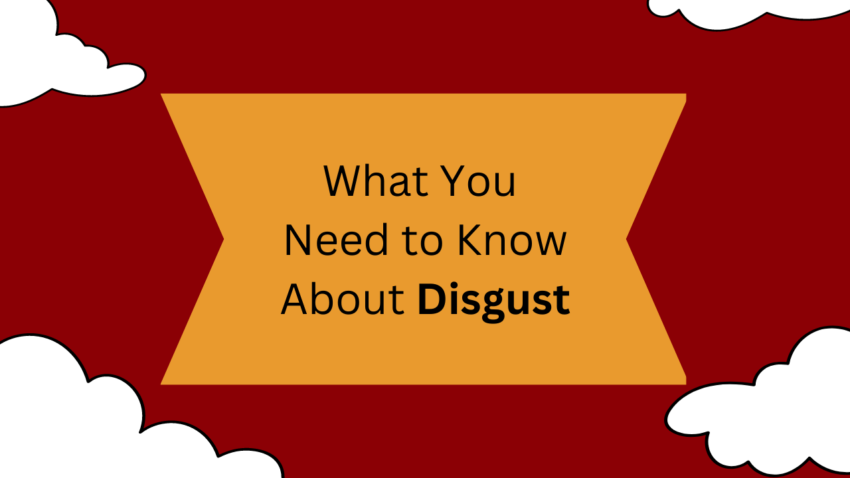Let’s Talk About Disgust
Disgust is a collection of protective emotions controlled by our nervous system instead of our brains. This emotion serves as an emergency response in some scenarios, and as an informative response in others. Basically, Disgust emotions either stop us from doing something dangerous in the moment, or they send us a message to watch for a problem in the future. Disgust helps defend us against poisons, diseases, and even moral decay.
What Are Disgust Emotions?
There are many ways to talk about Disgust emotions. This list may not be complete, but the English language has very few words for describing disgust, which can make it difficult to discuss or understand. Do note that there is overlap in the words we use for Disgust with other emotions, including outrage, horror, and hatred. This is because Disgust can prompt other emotional responses, and we tend to talk about the most recent emotion, rather than the initial emotion when we discuss our experiences.
- Nausea
- Distaste
- Revulsion
- Repulsive
- Hatred
- Disapproval
- Loathing
- Repugnance
- Gross
- Sickening
- Turn off
- Appall
- Outrage
- Horror
What’s the Point of Disgust?
Disgust is a complicated set of emotional responses which all share the same goal: Self-protection. Any time we experience Disgust emotions, our body is directing us to avoid a threat of some kind. Unlike Anger and Fear, Disgust isn’t a typical stress response. It’s more of an “In case of emergency, break glass” kind of setup. Disgust responses run constantly, helping us remember to not touch things that can make us sick, or to remember to cook meat long enough for safety. Until it’s triggered by something, we don’t really notice Disgust. But if we step in dog poo, or someone sneezes in our face, or we see someone groveling or behaving outside our values, our brain smashes the glass and Disgust turns into a fire extinguisher, shutting down everything until a solution to the threat is found, or we have navigated the threat without exposing ourselves.
Communication
When we experience Disgust, our subconscious is pointing a neon arrow at the threat, saying “Watch out!” Our attention is drawn very quickly to the item perceived as Disgusting, and we deprioritize other things in our environment. When we see someone else experience disgust, we instinctively look for the potential threat. Have you ever wondered why someone saying “Gross” or “Eww” can get your attention so fast? It’s because we are receiving a clear signal that Disgust is an appropriate emotion in that moment, and we need to identify the threat.
What Does Disgust Look/Feel Like?
Disgust can be a whole-body experience, or it can be localized to certain parts of the body. We might become nauseated, or vomit. We might make a face or cover our mouth or nose. We might also back away or feel unreasonably angry about something very quickly. The Action Urges for Disgust also include:
- Pushing away
- Throwing things
- Placing a barrier between yourself and the threat
- Washing
- Cleaning
- Changing clothing
- Yelling
- Being sarcastic or critical
- Anger
- Fear
Action Urge: The instinctive actions we feel the urge to do when we experience relevant emotions. For example, smiling when you’re happy, or crying when sad.
Seeing Disgust in Others
The easiest way to recognize Disgust in others is the “Disgust” face. The Disgust face includes lowered eyebrows, a scrunched up nose, a protruding bottom lip, and a raised upper lip. Beyond that, we might hear them say “eww” or “gross.” There are cultural differences in the words we use to indicate our disgust, so if you’re travelling internationally, don’t expect people to understand the words you use. For example, in Japanese, the “Eww” equivalent is:うわー which is pronounced something like “Waa”. The faces we make when we are disgusted also vary by culture, so it’s a good idea to learn how people experience Disgust in places you visit, because it might be very important to your safety, or someone else’s!
Changing Emotions with Disgust
In order to reduce or increase our Disgust, we can do a number of things, but nothing is guaranteed. For example, if there’s something you find disgusting that you want to find appealing, you can try Happiness-based strategies. Spending more time with the thing, thinking of how the thing can be good or beneficial, and saying nice things about it can all reduce our disgust response.
On the other hand, you can also use Disgust to reduce your emotional attachment to something. For example, if you find out your spouse has committed a crime, hurt an innocent, or lied to you in a way that violates your values, it’s actually possible to break your attachment (love) for them almost instantly. For example, I was dating someone that I learned was a registered sex offender. We had lived together for over a year, and when I found out, I couldn’t believe it. When I checked the State’s registry, however, I realized that this person had been keeping a very big secret from me for a long time.
Within an hour, I had moved from shock and sadness to disgust and anger. A couple of hours later, I realized I could not longer date them, even if there was a perfectly reasonable explanation for their status as a registered sex-offender, because I was disgusted by the lie that was inherent in them not telling me such an important truth. It turned out, this person had a reasonable explanation. They hadn’t committed a crime, but had been accused of said crime, and felt required to take the plea deal due to circumstances including poverty and the prospect of sitting in jail for years before seeing a judge. I confirmed the story with their family (who did not have a strong reason to lie to me) and felt less violated by having lived with them. I couldn’t, however, get over the lie. I was still Disgusted by their lack of integrity, and couldn’t rekindle any affection for them.
When Disgust Goes Wrong
When we have too much Disgust, we can develop disorders such as Obsessive Compulsive Disorder, which is characterized by ritual behaviors used to make one feel safe or clean. Excessive hand-washing, showering, and refusal to touch “gross” things are all symptoms of OCD driven by disgust. Disgust can also lead to eating disorders, or dietary problems. Young adults who are living on their own for the first time often have to learn how long they can keep fresh ingredients, and that learning process can often include spoilt food. When this happens too often, they may associate the Disgust with their refrigerator, their pantry, or even with food in general, making it progressively more and more difficult to maintain healthy eating habits.
When we don’t have enough Disgust, we may do or say things that lead other people to believe we are disgusting. This can come as a surprise for those who live in abusive situations for a long time, because traumatic experiences can skew our sense of Disgust, Anger, and Fear, changing how we interact with the world.
For example, during a period of being unhomed, I became desensitized to being the general sort of “dirty” that comes with not having access to daily showers. I (usually) didn’t smell bad, or look specifically unclean, but my hair was greasy, and my clothes were obviously not freshly laundered. I got in the habit of not washing as often, and not doing laundry as often. When I moved in with new roommates a few months later, one of them felt compelled to pull me aside and ask me to shower more regularly. He stressed that I didn’t smell bad, it was just obvious I hadn’t showered, and it made other people uncomfortable.
This was embarrassing, to be sure, but more critically, it made me feel disgusted with myself. I started showering every day, sometimes more than once, until I realized a few years later that I was habitually showering twice or more a day, and that it was causing problems for my skin. It wasn’t until I was in therapy for some time that I learned that the problem was my own relationship with disgust. These days, I shower once a day on average, and only shower more often if there’s a real need.
Is Disgust Useful?
Disgust is one of the universal emotions, responsible for keeping us safe and clean. We can use it to help us recognize threats, and avoid illness. We can also use it to influence others. Unfortunately, this means it can be used to influence us, as well. Politicians often employ Disgust, and its Anger counterpart Outrage, to influence how we vote. If someone needs your support, and the things they tell you make you feel like someone else is Disgusting, they may be trying to manipulate you with this emotion, in order to secure your vote.
Want More Disgust Topics?
This is our last Emotion Category, which means that starting next week, we’ll begin exploring specific strategies for increasing or decreasing emotions, and ways to better understand our emotions to regain a healthy relationship with them. Stay tuned for those skills-based videos. I’ve seen them help so many people over the years, and I’m excited to share them with you.

